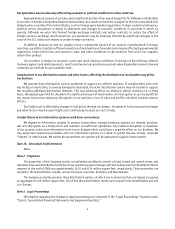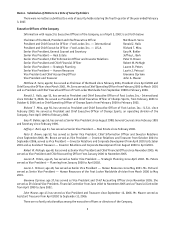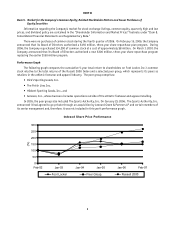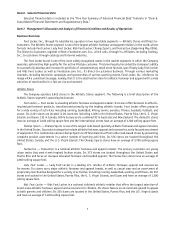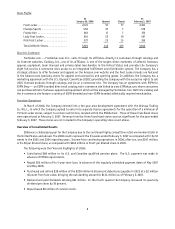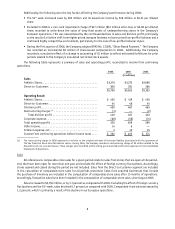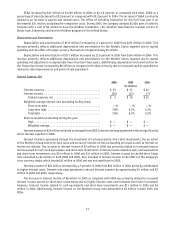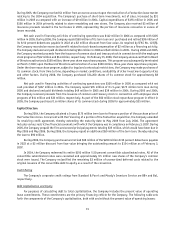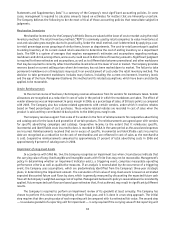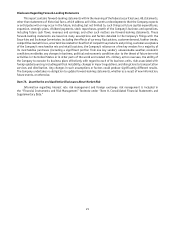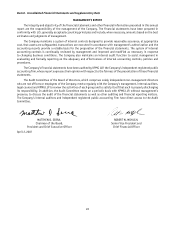Foot Locker 2006 Annual Report Download - page 30
Download and view the complete annual report
Please find page 30 of the 2006 Foot Locker annual report below. You can navigate through the pages in the report by either clicking on the pages listed below, or by using the keyword search tool below to find specific information within the annual report.
14
Liquidity and Capital Resources
Liquidity
Generally, the Company’s primary source of cash has been from operations. The Company usually finances real
estate with operating leases. The principal uses of cash have been to fund inventory requirements, capital expenditures
related to store openings, store remodelings, and management information systems and other support facilities, and
other general working capital requirements.
Management believes operating cash flows and current credit facilities will be adequate to fund its working
capital requirements, scheduled pension contributions for the Company’s retirement plans, scheduled debt repayments,
anticipated quarterly dividend payments, potential share repurchases, and to support the development of its short-
term and long-term operating strategies.
Planned capital expenditures for 2007 are approximately $170 million, of which $144 million relates to new store
openings and modernizations of existing stores, and $26 million reflects the development of information systems and
other support facilities. The Company has the ability to revise and reschedule the anticipated capital expenditure
program, should the Company’s financial position require it.
Maintaining access to merchandise that the Company considers appropriate for its business may be subject to the
policies and practices of its key vendors. Therefore, the Company believes that it is critical to continue to maintain
satisfactory relationships with its key vendors. The Company purchased approximately 78 percent in 2006 and 75
percent in 2005 of its merchandise from its top five vendors, in each respective year, and expects to continue to obtain
a significant percentage of its athletic product from these vendors in future periods. Approximately 50 percent in 2006
and 49 percent in 2005 was purchased from one vendor — Nike, Inc. During 2006, two of our key vendors merged, the
Company’s purchases from this vendor totaled 14 percent.
Any materially adverse change in customer demand, fashion trends, competitive market forces or customer
acceptance of the Company’s merchandise mix and retail locations, uncertainties related to the effect of competitive
products and pricing, the Company’s reliance on a few key vendors for a significant portion of its merchandise purchases,
risks associated with foreign global sourcing or economic conditions worldwide could affect the ability of the Company
to continue to fund its needs from business operations.
Cash Flow
Operating activities from continuing operations provided cash of $189 million in 2006 as compared with $349
million in 2005. These amounts reflect income from continuing operations adjusted for non-cash items and working
capital changes. During 2006, the Company recorded a non-cash impairment charge of $17 million related to the
operations in Europe. The decline in operating cash flows of $160 million is primarily due to a reduction of accounts
payable at year-end reflecting an acceleration of inventory receipts earlier in the fourth quarter of 2006. In addition,
due to the calendar shift related to the 53rd week, approximately $47 million of the decline represents the timing of
lease payments. Additionally, the Company contributed $68 million to its U.S. and Canadian qualified pension plans in
2006, as compared with contributions of $26 million in 2005.
Operating activities from continuing operations provided cash of $349 million in 2005 as compared with
$272 million in 2004. The net increase in operating cash flows of $77 million is primarily due to improved operating
performance and changes in working capital primarily related to changes in merchandise inventories, offset by the
related payables and lower pension contributions of $26 million in 2005 as compared with $106 million in 2004.
Net cash used in investing activities of the Company’s continuing operations was $108 million in 2006 as compared
with $182 million in 2005. The Company’s purchase of short-term investments, net of sales, decreased by $49 million in
2006 as compared with an increase of $31 million in 2005. Capital expenditures of $165 million in 2006 and $155 million
in 2005 primarily related to store remodeling and new stores. During 2006, the Company received net proceeds of $4
million as a result of a lease termination. The Company also received $4 million of insurance proceeds from its insurance
carriers related to the final settlement of the property and equipment claims for the 2005 hurricane.
Net cash used in investing activities of the Company’s continuing operations was $182 million in 2005 as compared
with $407 million in 2004. During 2004, the Company paid $226 million for the purchase of 349 Footaction stores from
)QQVUVÜT,PEÜPFRÜKFaOKNNKQPÜRRTQZKOÜVGN[OKNNKQPHQTVJGRWTEJÜUGQHUVQTGUKPVJG5GRWDNKEQH,TGNÜPF


